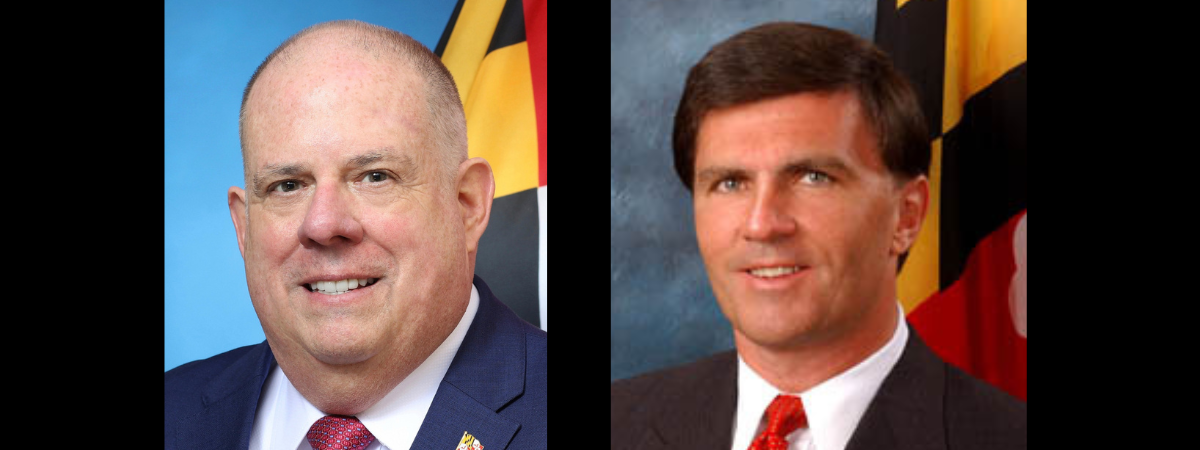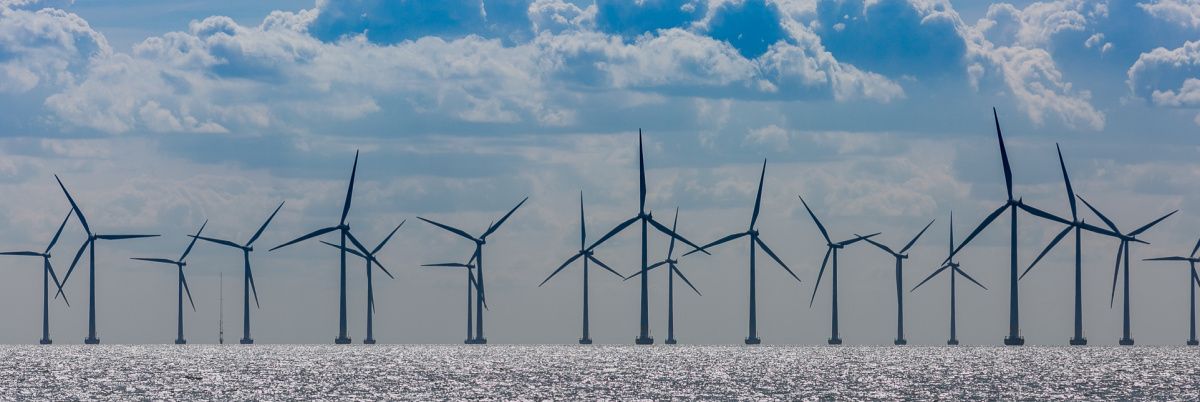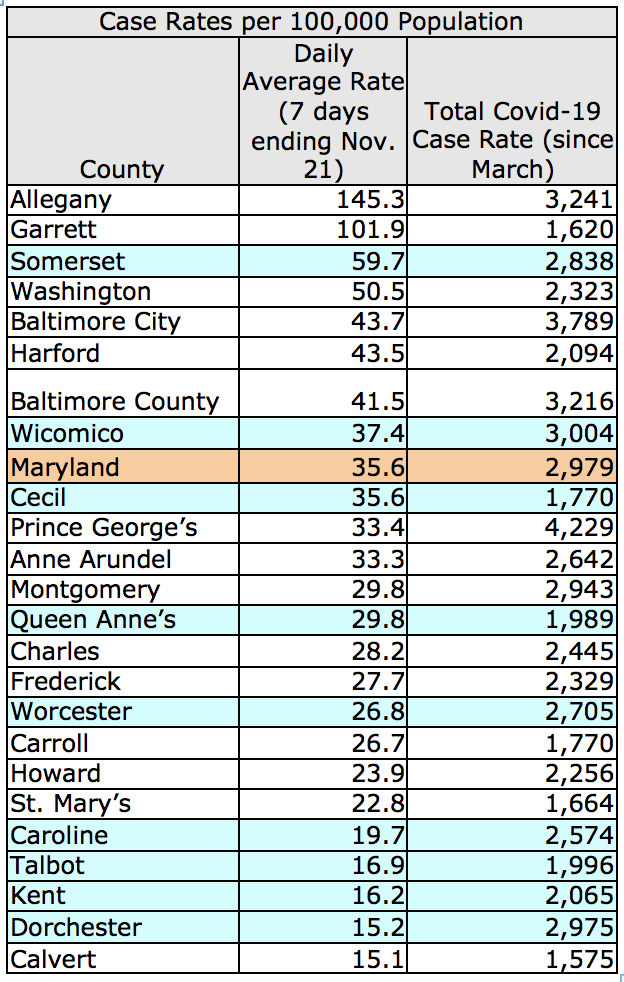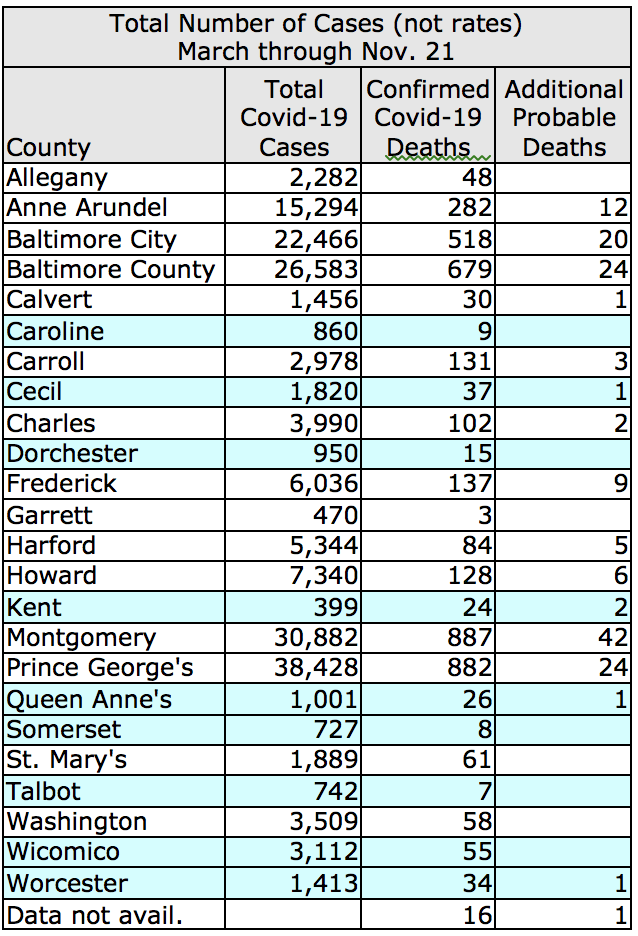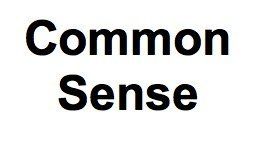Covid-19 Cases Increase Sharply on the Eastern Shore, Throughout Maryland, and Across the World

To better allow comparison, the rates reported here are for the average number of new cases over the seven days ending Saturday, Nov. 21, and are adjusted per 100,000 population.
As of Nov. 21, of all the 50 U.S. states plus the District of Columbia and five U.S. territories, North Dakota had the highest weekly rate of new cases at 176.5 per 100,000. Wyoming and South Dakota were the second and third highest with similar new-case rates of 142.9 and 141.2. Minnesota at 125 and Nebraska at 123.6 were fourth and fifth.
Five other states also had rates over 100 — Iowa, Montana, Wisconsin, Utah, and New Mexico — for a total of 10 states averaging over 100 new cases per day. Two weeks ago there were only three states with rates over a 100, and the highest rate then was North Dakota at 136. Now the highest is 176.5 and rising. Nationwide, the average number of new cases per day has increased 67 percent from the average two weeks ago. Covid-19 is surging at an alarming rate across America.
Further down the list as the 22nd and 23rd highest rates, Tennessee and Kentucky had almost identical new-case-per-day rates of 63.1 and 63.2. Their nearby neighbor to the north, Ohio, was just a little bit higher at 64.6. However, Ohio’s nextdoor neighbor to the west, Indiana, was almost 50 percent higher at a rate of 97.2 new cases per day.
Keep in mind that these statistics are all very fluid. It takes only a few days to a week or so for a town or county to go from a low rate to a high rate. About a month ago, Indiana and Maryland had nearly the same new-case rates. Both states have seen increases since then but Indiana’s rate has grown much faster, and on Saturday was at 97.2, almost three times Maryland’s rate of 35.6. This virus is very contagious and fast moving. By the time you read this, numbers will be different everywhere with states — as well as counties within states — constantly trading places on the list of places with the highest case rates.
Maryland’s new-case rate of 35.6 as of Nov. 21 may look good compared to other states. On Saturday, Maryland ranked 38th highest rate among the 56 states and territories. North Dakota’s rate is five times higher. But Maryland is only good in comparison to the states that are currently worse off. The Maryland rate is actually very troubling. Just a few weeks ago, Maryland’s rate was under 20. This Nov. 21 rate represents a sharp increase of 110 percent over the previous two weeks. That’s over twice as many people per day diagnosed with covid-19 as during the previous two weeks. Officials are worried that Maryland is headed in the same direction as the current hotspots. Hospitals in some areas of the state are beginning to feel the pressure.
Much of Maryland’s increase has been on the western side of the Chesapeake Bay with Allegany County as the state’s main hotspot. Allegany had a rate of 145.3 on Nov. 21 — more than double its rate at the end of October. That’s higher than the entire state of Indiana and over four times the Maryland average of 35.6. In fact, if Allegany were a state rather than a county, it would have the second highest covid-19 rate in the U.S., right after North Dakota. Allegany’s rate was almost 50 percent higher than Garrett, the second highest Maryland county at 101.9.
As a whole, the Eastern Shore of Maryland is a mixed bag. Earlier in the fall, the Eastern Shore had a number of hotspots and some of the highest rates in the state. This was especially true for nursing homes as well as crowded meat and poultry processing plants. Since then, all Eastern Shore counties have seen increases in their rates but many other counties have increased faster and now have higher rates. In fact, four of the five lowest rates in the state were Eastern Shore counties. These were Caroline (19.7), Talbot (16.9), Kent (16.2), and Dorchester (15.2). The lowest rate was on the Western Shore in Calvert (15.2).
On the other hand, the third highest rate in the state was 59.7 in Somerset County on the Eastern Shore. While still significantly below Allegany and Garrett counties, Somerset’s rate has more than doubled from what it was at the end of October.
But, as noted before, these rates can change quickly. It’s a roller-coaster ride with hotspots cropping up rapidly in one place, then another.
All of this has resulted in Gov. Larry Hogan tightening the covid-19 restrictions in Maryland. Beginning Nov. 10, new regulations limited indoor gatherings to 25 people and returned all governmental offices to mandatory work-at-home status. Starting Nov. 11, all bars and restaurants can operate at only 50 percent capacity — reduced from 75 percent — and must comply with distanced servicing rules for both customers and staff.
Then on Nov. 20, more restrictions were added, including several to address the special problems of hospitals, nursing homes, and other medical facilities. For the complete text of Maryland’s Nov.10 and Nov. 20 Emergency Orders regarding covid-19, click on the links at the end of this article.
Effective Nov. 20, all bars, restaurants, and other businesses with indoor seating for food and alcohol must close between 10 p.m. and 6 a.m. Carryout and delivery services may continue. Retail and religious facilities must reduce capacity to 50 percent. No spectators will be allowed at any racetracks or at any professional, school, or other stadium events.
Until further notice, the emergency order prohibits all hospital visitation with some exceptions — including end-of-life care, obstetrics, parents or guardians of minors, and support for people with disabilities. Also, visitation at Maryland nursing homes is limited to compassionate care only, and all visitors must have proof of a negative covid-19 test result within 72 hours before visiting.
Hogan stated that if we want to bring covid-19 under control in Maryland, officials, inspectors, etc., will need to start cracking down on places and persons not complying with these necessary regulations. “We are in a war right now, and the virus is winning,” he said.
Maryland State and County Covid-19 Statistics as of Nov. 21
The first chart below from the New York Times shows the case rates since the beginning of the pandemic and the daily average of new cases for the week ending Nov. 21. All rates are adjusted per 100,000 population.
Source of above chart: New York Times Covid-19 Interactive Database
The next four charts from the Maryland Department of Health show the total numbers of cases (not rates) and related deaths since the beginning of the pandemic in March 2020 and include data by age, gender, and ethnicity.
Source of the above four charts of raw numbers by county, age, gender, and ethnicity: Maryland State Coronavirus Website
Maryland State Emergency Order on Covid-19, Nov 20, 2020
Maryland State Emergency Order on Covid-19, Nov 10, 2020
Jane Jewell is a writer, editor, photographer, and teacher. She has worked in news, publishing, and as the director of a national writer's group. She lives in Chestertown with her husband Peter Heck, a ginger cat named Riley, and a lot of books.
Common Sense for the Eastern Shore

